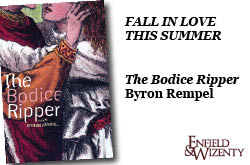By Michelle Berry
You’ve heard it before: writing is hard work. I know, I know, it’s not as hard as a lot of jobs, but still. It’s physically hard — back-breakingly, carpal-tunnel-inducingly, ass-flatteningly difficult. Sometimes I can’t even get up from my chair I’m so stiff. I drape my arms over the side of the bed when I sleep so the blood stays in them. Writing is also mentally, emotionally, solitarily draining. Sometimes, after writing all day, I can’t form a complete sentence in my mind. There’s no way I can speak one. “Me hungry” is the closest I come to expressing myself. All day my brain moves into the tips of my fingers (which have been drained of blood) as they hit the keyboard. I can’t even try to move it back until I’ve had a glass of wine.
Writing is hard work.
I tell my students this all the time. They don’t believe me.
Until they start actually writing.
Really writing. And editing.
My new novel, “Interference,” was the hardest thing I’ve written yet. For some reason, several years ago, I thought it would be a good idea to write each chapter of this novel I was working on as fully formed short stories instead of chapters. I thought hey, writing a novel is a lonely and long process, what if I send out a few chapters in the meantime as short stories? Just to see if they sell? Just to keep me in the publishing game? Just to see if anyone out there likes them? So I did this. And, luckily, the four I sent out got published (The Winnipeg Review, actually, published one).
It’s hard enough to write a short story, let alone combine it with a novel. And I don’t mean a collection of connected short stories, I mean a novel written in short stories. My novel has a plot – an overarching arc. But so does each chapter. Each chapter can stand on its own (I hope – after the thousandth read I’ve lost the ability to tell). The hardest part in this whole thing was taking all these short stories and forcing them into novel-format: layering them, connecting them, creating tension and forward movement and climax. And doing all this without rupturing the form of the chapters or novel as a whole.
Ack. I said this a lot during the process. Ack.
So I printed out all the stories/chapters. I placed them all around me on the floor. That didn’t work. I was stepping on them all the time. My dog was sitting on them. Then I went out and bought a huge dry erase board and a bunch of coloured pens and started to map it all out. A very pretty picture emerged – colourful. Mapping, I realized that the book takes place over one hockey season – okay, I thought, and clung onto that – my novel would revolve around the seasons. This meant making sure the stories I thought took place in spring actually took place in the fall, etc.. My editor at ECW Press, Michael Holmes, was brilliant and a few times caught it middle-of-winter-snowing in October before Halloween.
I also realized, on my pretty impressive board, that transitioning from chapter to chapter wouldn’t work within the short story form. Chapters, after all, end with a rise – to get you to read on. Stories end. I needed something. I had begun the novel with a letter from the school principal warning of a mysterious man in a van stalking children. Letters! What a great idea. Weave letters in and out of the story/chapters to connect everything. When I finished with that I realized that the letters themselves actually tell other stories, so I suddenly had layers upon layers happening – short stories, chapters, letters, novel.
Then I changed the names of some of the characters. Because they were too similar-sounding and weren’t working anymore with who the characters had become after each edit. At this point my brain exploded. Like a puzzle, or like weaving/knitting or something… I don’t know (I don’t knit or do puzzles)…. everything was so complicated and needed physical shuffling. I really wanted to take the characters and situations and move them all around with my hands. I wanted to touch them physically, to mold them like clay. Instead, I had to do that with my head.
Sometimes I think I’d rather be an artist. If I had any talent. There must be something so satisfying about putting paint on canvas and seeing it right there in front of you, with being able to manipulate it, to scrape it off or blend it with another colour or make it thick like mucous or thin and watery. With writing you have to read a whole bunch of little black lines and squiggles, put them together, and then imagine them. It can take hours of reading in order to see the whole picture. A painting should, of course, take time to appreciate, but you can cheat and look quickly and see it all in front of you at once.
Eventually, after shuffling, drawing, molding, knitting, weaving, layering, name-changing, season-organizing, I called in the specialists – those reader/writer friends and family members who have keen eyes and critical editing skills. With their help, Interference became the novel it is now. And to think I thought that writing each chapter as its own short story would be the easy thing to do? Next time I write a novel I start at the beginning and write until the end.





One Comment
Thanks to Michelle Berry for her wonderful and excruciating description of the novel-writing process.